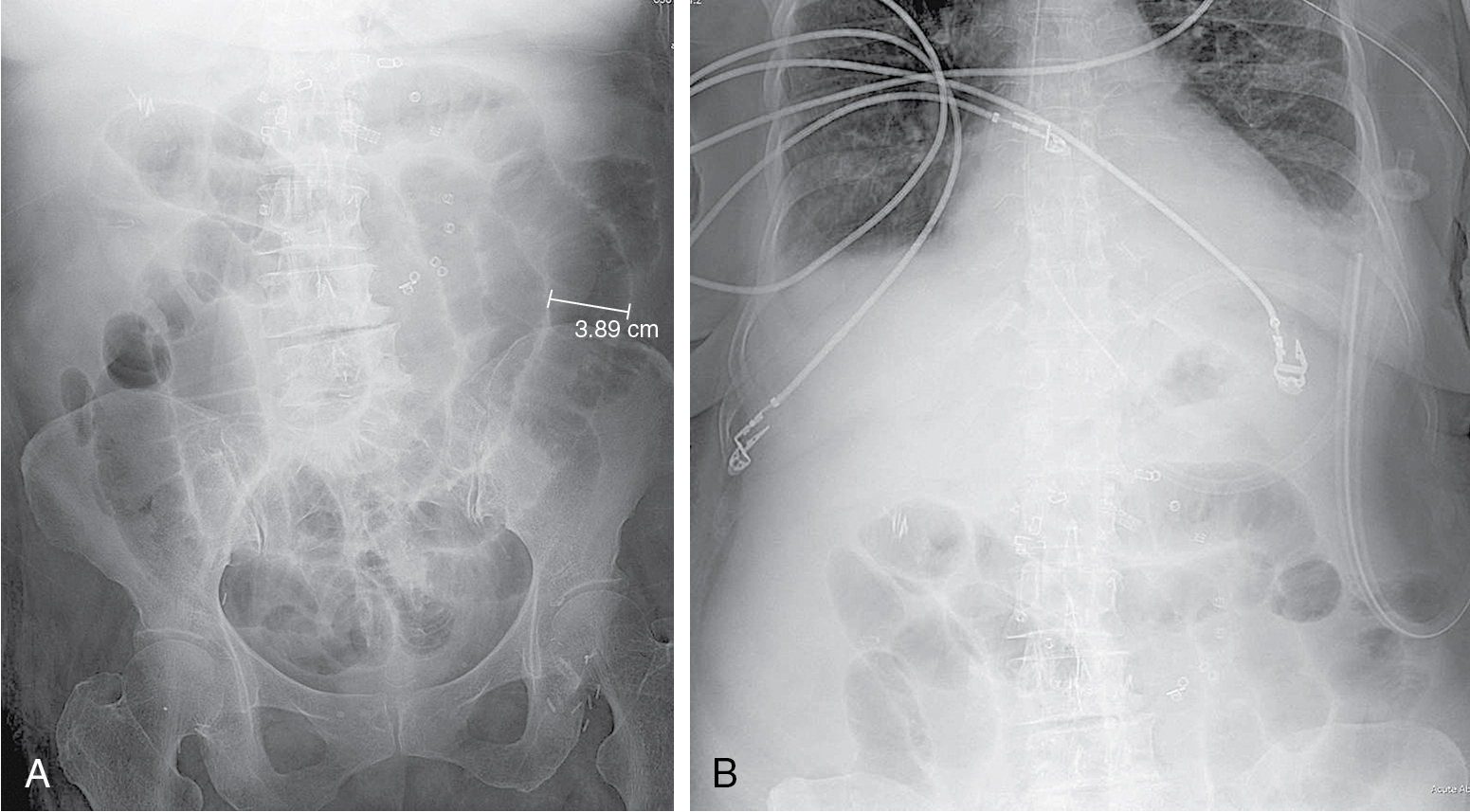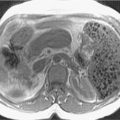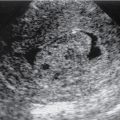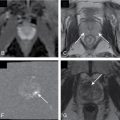Anatomy, embryology, pathophysiology
- ◼
The small bowel is a long, mobile, and compressible tubular structure located in the mid-abdomen, surrounded circumferentially by the large bowel.
- ◼
The small bowel caliber is normally smaller than 3 cm (outer wall to outer wall).
- ◼
The small bowel wall is normally smaller than 3 mm in width.
- ◼
Valvulae conniventes are the small bowel’s characteristic circumferential mucosal markings. They are the thickest and largest in the jejunum and decrease in caliber in the ileum, where they disappear in the terminal ileum.
- ◼
The small bowel consists of three segments: duodenum, jejunum, and ileum.
- ◼
The duodenum has four segments. The first (superior) portion is the continuation of the pylorus and courses to the right at the level of the gallbladder neck. The first segment is also referred to as the duodenal bulb. The second (descending) portion lies between the gallbladder neck and genu of the duodenum, which is usually at the L4 vertebral body level. The third (horizontal) portion extends from the genu to the aorta. The fourth (ascending) portion extends from the aorta to the ligament of Treitz, which signifies the beginning of the jejunum.
- ◼
The duodenum has a characteristic shape on frontal projections referred to as the C-loop.
- ◼
The jejunum lies in the left upper quadrant.
- ◼
The ileum lies in the mid-pelvis and terminates at the ileocecal valve, which is in the right lower quadrant in patients with normal gut rotation.
- ◼
- ◼
Small bowel obstructions (SBO) are a potential surgical emergency. SBO occurs when there is mechanical blockage of forward flow of intestinal contents, and if not treated appropriately, can lead to perforation, ischemia, and bowel necrosis. This is in contrast to adynamic ileus, where a functional deficit leads to lack of bowel peristalsis and stasis of contents.
- ◼
In developed countries, the vast majority of SBO (~85%) is caused by adhesions from prior abdominal surgery. In developing countries, SBO is most commonly the result of inguinal hernias.
Techniques
Abdominal radiography
- ◼
Abdominal radiographs are routinely acquired as the first imaging study in the evaluation of small bowel obstructions. The accuracy of abdominal radiographs is quoted as 50%–86%. The accuracy in diagnosing small bowel obstructions significantly improves with both dependent (supine or prone) and nondependent (upright or decubitus) views.
- ◼
The classic small bowel obstruction pattern on radiographs is the presence of small bowel loops dilated with gas and/or fluid with a gasless colon ( Fig. 5.1 ). Small bowel loops will be dilated (>3 cm) out of proportion compared with the colon. Air within the colon suggests against complete SBO, but could represent early SBO, partial obstruction, or adynamic ileus.

Fig. 5.1
Complete small bowel obstruction. A, Erect radiograph from an acute abdominal series of a 76-year-old woman shows multiple dilated loops of small bowel with air/fluid levels up to 3.9 cm in width. There is no air in the colon, which suggests that the obstruction is complete. This patient has had multiple prior abdominal surgeries, as noted by the clips and mesh repair coils on the radiograph. B, Supine radiograph of the same patient confirms the findings. There is no free intraperitoneal air.
(From Sahani DV, Samir AE. Abdominal Imaging , ed 2. Philadelphia: Elsevier; 2017.)
- ◼
It is important to also recognize the gasless abdomen. The absence or paucity of bowel gas may be caused by fluid filled dilated small bowel loops and may indicate a high-grade or closed loop obstruction.
- ◼
On upright or decubitus views, the presence of multiple air-fluid levels, air-fluid levels longer than 2.5 cm, or air-fluid levels within the same bowel loop but of different heights can establish the diagnosis of SBO.
- ◼
Complications of SBO that may be visible on plain radiograph include pneumoperitoneum from perforated bowel and pneumatosis and/or portal venous gas from bowel ischemia.
- ◼
Administration of a water-soluble, hyperosmolar contrast agent (such as Gastrografin) has been shown to have therapeutic and diagnostic benefits. The hypertonicity of the contrast agent draws water into the bowel lumen, reducing bowel wall edema and stimulating peristalsis.
Computed tomography
- ◼
Multidetector computed tomography (CT) is the all-purpose modality to evaluate for suspected SBO. The sensitivity is approximately 70% to 90%, with higher sensitivity (81%–100%) for high-grade SBO.
- ◼
Multidetector CT allows the radiologist to confirm and localize a transition point between dilated and decompressed small bowel, as well as determine the severity of the SBO. Multiplanar reformats can be used to identify the transition point of SBO more reliably and to assess adjacent structures, as well as the mural and extramural extent of small bowel lesions.
- ◼
CT is also used to identify the cause of mechanical obstruction (see benign and malignant causes of small bowel obstructions later).
Protocols
- ◼
Intravenous (IV) contrast is routinely used to evaluate for bowel wall and mucosal enhancement, possible inflammatory or neoplastic processes, and mesenteric vasculature. If there is a high index of suspicion for bowel ischemia, an arterial and venous phase is recommended to search for occluded arteries and veins.
- ◼
The use of oral contrast is controversial. Although oral contrast may help define the transition point, many patients with SBO are nauseated and may vomit, potentially aspirating the oral contrast. In addition, there is typically a 2 to 3 hour delay in performing the CT after oral contrast is given, which may delay management of high-grade bowel obstructions that require immediate surgical intervention. At our institution, we find the fluid accumulation within the lumen of the obstructed bowel segment provides excellent negative contrast to define the transition point, and thus do not routinely give positive oral contrast.
Specific disease processes
Small bowel obstruction
- ◼
It is important to determine and accurately convey the severity of obstruction. The following definitions classify the severity of obstruction:
- ◼
Complete/high grade obstruction: total luminal occlusion with lack of gas and fecal material in the colon or nondistended small bowel.
- ◼
Incomplete/partial obstruction: some fluid/gas pass beyond the obstruction point.
- ◼
Strangulated obstruction: small bowel obstruction with bowel ischemia.
- ◼
Closed loop obstruction: bowel segment is obstructed at two points that are adjacent to each other.
- ◼
- ◼
Classic imaging findings:
- ◼
Disproportionately dilated small bowel loops with air/fluid levels.
- ◼
Absent or minimal gas in the colon.
- ◼
Transition zone.
- ◼
Collapsed small bowel loops distal to the obstruction.
- ◼
“Small-bowel feces” sign: stasis and mixing of gas and fluid proximal to the obstruction, which has the appearance of colonic feces, indicating mechanical obstruction.
- ◼
- ◼
Bowel ischemia as a result of obstruction needs to be recognized and emergently brought to the attention of the surgical team. Signs of bowel ischemia include:
- ◼
Decreased arterial enhancement and increased enhancement on the venous phase within a segment of bowel. This is highly specific for bowel ischemia.
- ◼
Pneumatosis.
- ◼
Portal venous gas.
- ◼
Bowel wall thickening greater than 3 mm (think venous ischemia) versus paper thin bowel wall (think arterial ischemia).
- ◼
Mesenteric edema or fluid (more common with venous ischemia).
- ◼
Benign causes of small bowel obstruction
- ◼
Adhesions: the most common cause in developed countries. Adhesions are rarely seen on imaging but can be inferred when there is an abrupt caliber change in the absence of another obstructing cause ( Fig. 5.2 ). Postoperative adhesions can occur as early as 4 weeks after surgery or years after surgery.











